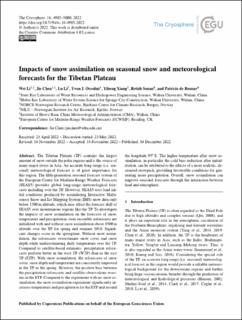| dc.contributor.author | Li, Wei | |
| dc.contributor.author | Chen, Jie | |
| dc.contributor.author | Li, Lu | |
| dc.contributor.author | Orsolini, Yvan J. | |
| dc.contributor.author | Xiang, Yiheng | |
| dc.contributor.author | Senan, Retish | |
| dc.contributor.author | De Rosnay, Patricia | |
| dc.date.accessioned | 2022-12-22T08:22:44Z | |
| dc.date.available | 2022-12-22T08:22:44Z | |
| dc.date.created | 2022-12-19T09:03:34Z | |
| dc.date.issued | 2022 | |
| dc.identifier.citation | The Cryosphere. 2022, 16, 4985-5000. | en_US |
| dc.identifier.issn | 1994-0416 | |
| dc.identifier.uri | https://hdl.handle.net/11250/3039161 | |
| dc.description.abstract | The Tibetan Plateau (TP) contains the largest amount of snow outside the polar regions and is the source of many major rivers in Asia. An accurate long-range (i.e. seasonal) meteorological forecast is of great importance for this region. The fifth-generation seasonal forecast system of the European Centre for Medium-Range Weather Forecasts (SEAS5) provides global long-range meteorological forecasts including over the TP. However, SEAS5 uses land initial conditions produced by assimilating Interactive Multisensor Snow and Ice Mapping System (IMS) snow data only below 1500 m altitude, which may affect the forecast skill of SEAS5 over mountainous regions like the TP. To investigate the impacts of snow assimilation on the forecasts of snow, temperature and precipitation, twin ensemble reforecasts are initialized with and without snow assimilation above 1500 m altitude over the TP for spring and summer 2018. Significant changes occur in the springtime. Without snow assimilation, the reforecasts overestimate snow cover and snow depth while underestimating daily temperature over the TP. Compared to satellite-based estimates, precipitation reforecasts perform better in the west TP (WTP) than in the east TP (ETP). With snow assimilation, the reforecasts of snow cover, snow depth and temperature are consistently improved in the TP in the spring. However, the positive bias between the precipitation reforecasts and satellite observations worsens in the ETP. Compared to the experiment with no snow assimilation, the snow assimilation experiment significantly increases temperature and precipitation for the ETP and around the longitude 95∘ E. The higher temperature after snow assimilation, in particular the cold bias reduction after initialization, can be attributed to the effects of a more realistic, decreased snowpack, providing favourable conditions for generating more precipitation. Overall, snow assimilation can improve seasonal forecasts through the interaction between land and atmosphere. | en_US |
| dc.language.iso | eng | en_US |
| dc.rights | Navngivelse 4.0 Internasjonal | * |
| dc.rights.uri | http://creativecommons.org/licenses/by/4.0/deed.no | * |
| dc.title | Impacts of snow assimilation on seasonal snow and meteorological forecasts for the Tibetan Plateau | en_US |
| dc.title.alternative | Impacts of snow assimilation on seasonal snow and meteorological forecasts for the Tibetan Plateau | en_US |
| dc.type | Peer reviewed | en_US |
| dc.type | Journal article | en_US |
| dc.description.version | publishedVersion | en_US |
| dc.rights.holder | © Author(s) 2022. | en_US |
| dc.source.pagenumber | 4985-5000 | en_US |
| dc.source.volume | 16 | en_US |
| dc.source.journal | The Cryosphere | en_US |
| dc.identifier.doi | 10.5194/tc-16-4985-2022 | |
| dc.identifier.cristin | 2094932 | |
| dc.relation.project | NILU - Norsk institutt for luftforskning: 121136 | en_US |
| dc.relation.project | Norges forskningsråd: 325519 | en_US |
| cristin.ispublished | true | |
| cristin.fulltext | original | |
| cristin.qualitycode | 2 | |

